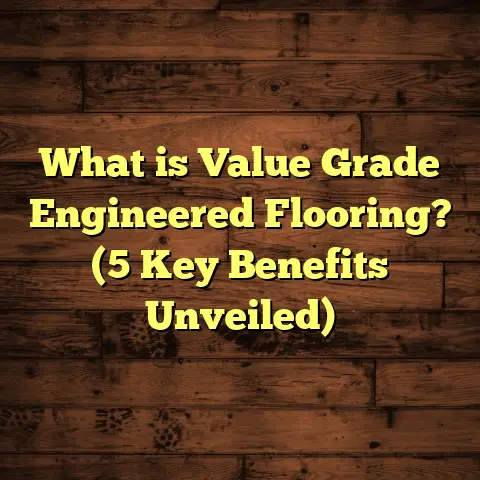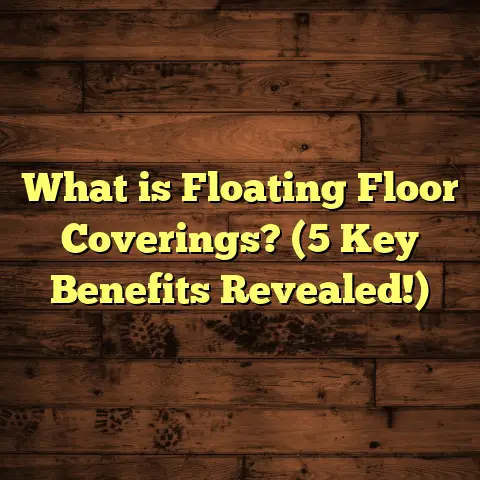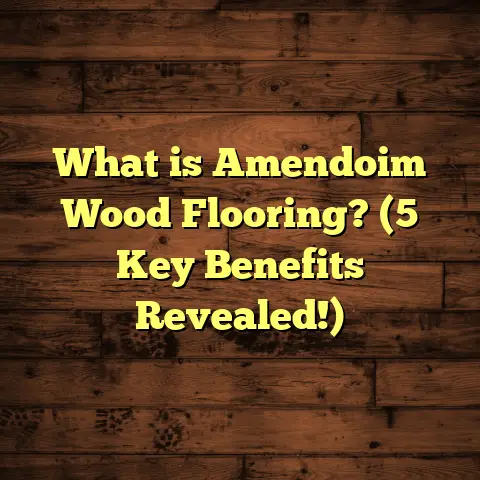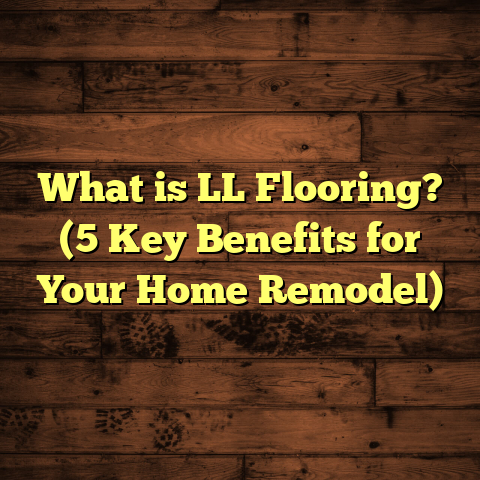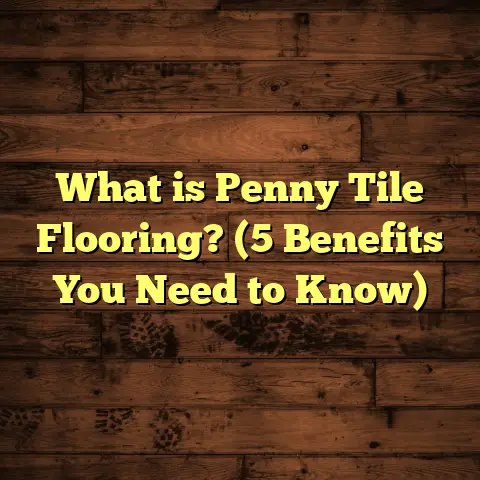What is Flooring? (5 Types You Need to Know for Your Home)
Have you ever stopped to think about what really makes a house feel like a home? What’s under your feet shapes how you walk, how a room feels, even how you relax or work. For me, flooring is one of those things that’s easy to overlook—until you start thinking about it seriously. Then you realize it’s a huge part of your everyday life and a big factor in your home’s style and comfort.
So, what exactly is flooring? Let me walk you through it.
What Is Flooring?
Flooring is the material or finish applied to the structural floor base of a building. It’s the surface we step on, but it’s also a protective layer for the structure beneath. Flooring serves to provide safety, comfort, functionality, and aesthetic appeal. It can be made from natural materials like wood and stone or synthetic ones like vinyl and laminate.
When I first started working in flooring, I thought it was just about picking something that looked nice. But over time, I realized there’s a lot more to it: durability, moisture resistance, maintenance needs, installation complexity, costs—the list goes on. And each choice impacts your lifestyle in subtle but important ways.
The material you pick affects the entire feel of your home. It influences acoustics (how sound travels), warmth (thermal insulation), and even air quality (some materials trap allergens; others don’t). Plus, flooring is an investment—some types last decades while others might need replacing every few years.
Over the years, I’ve worked with hundreds of homeowners choosing flooring for everything from tiny apartments to large estates. I’ve seen firsthand how the right floor transforms spaces—from adding cozy vibes to modern chic looks. I want to share the five most common and essential flooring types you should know about if you’re planning for your home. Along the way, I’ll share tips, data-backed facts, and stories from my own work.
Hardwood: Timeless Elegance That Lasts Generations
Hardwood is probably the most classic flooring choice out there. It’s made from solid wood planks—oak, maple, cherry, hickory, walnut—the list of species is long. The beauty of hardwood comes from its natural grain patterns and ability to be refinished multiple times.
Why Hardwood?
I remember my first hardwood installation project vividly. It was an older home with original oak floors that had worn down over 70 years. The client wanted to restore their original charm but also add modern durability. We sanded the floors down to bare wood and applied three coats of polyurethane finish. The transformation was stunning—the floor looked brand new but still had that warm patina unique to aged wood.
Here’s what makes hardwood so popular:
- Longevity: Hardwood floors can easily last 50 to 100 years if cared for properly. They can be sanded and refinished up to 5–7 times depending on thickness.
- Cost: Hardwood materials usually cost $5 to $10 per square foot. Including professional installation, expect $8 to $15 per square foot.
- Installation Time: A 1,000-square-foot area can take anywhere from 3 to 7 days depending on complexity.
- Variety: Planks vary in width from narrow strips (2.25 inches) to wide planks (up to 7 inches or more). Different wood species offer diverse colors and grains.
- Maintenance: Sweeping or vacuuming regularly and refinishing every 7–10 years keeps hardwood looking great.
Hardwood in Real Homes: A Case Study
I worked on a 1920s Craftsman bungalow where the owners wanted authentic hardwood floors throughout the living spaces. We selected quarter-sawn white oak with a matte finish to reduce glare and minimize scratches visibility.
The homeowners reported that after two years, the floors still looked fantastic despite having two young kids and a Labrador retriever running around. The floors were easy to clean with just weekly sweeping and occasional damp mopping.
According to a study by the National Wood Flooring Association (NWFA), hardwood floors can increase resale value by up to 2%. That might not sound like much at first glance, but if your home is worth $300,000, that’s an extra $6,000—just from flooring!
What You Should Know About Hardwood
- Not Ideal for Moist Areas: Hardwood expands and contracts with moisture changes; avoid bathrooms or basements unless properly sealed.
- Scratches Show Up: Natural wood dents and scratches add character but may be a downside for some.
- Refinishing Work: Refinishing removes surface damage but involves sanding dust and downtime.
Laminate: Affordable Lookalike That Handles Life’s Chaos
Laminate flooring is made of composite wood pressed together at high temperatures with a photographic layer on top that mimics real wood or stone textures. Then it’s covered with a durable wear layer.
Why Laminate?
When I first encountered laminate floors on a project for a busy family with two toddlers and a dog, I was impressed by its resilience. The client wanted something that looked like hardwood but could stand up to spills, scratches, and heavy foot traffic without breaking the bank.
Here are some key points about laminate:
- Cost: Laminate is highly affordable—materials often range from $0.99 to $3 per square foot. Total installed cost typically runs $1.50 to $5 per square foot.
- Installation Speed: Many laminate products use click-lock designs allowing DIY installations. A typical 500-square-foot room could be done in a weekend.
- Durability: Laminate resists scratches and stains well but isn’t water-proof unless you get specialized versions.
- Appearance: High-definition printing technology has improved laminate’s look so much that it’s hard to tell apart from real wood or tile.
- Maintenance: Requires regular sweeping; damp mopping with laminate-safe cleaners works fine.
My Laminate Insight
One homeowner wanted kitchen flooring that could handle heavy cooking messes but didn’t want cold tile underfoot. We installed AC4-rated laminate (rated for heavy residential use) with beveled edges that give extra dimension.
That laminate kitchen floor has held up for over five years now without signs of wear even with daily cooking spills and kids running around.
Statistically speaking, laminate flooring sales have increased by over 6% annually in North America over the past decade because of affordability combined with improved aesthetics.
What You Should Keep In Mind
- Water Sensitivity: Standard laminate swells when exposed to water; avoid installing in bathrooms or basements unless it’s waterproof laminate.
- Sound: Laminate can feel hollow or noisy when walked on without proper underlayment.
- Cannot Refinish: Unlike hardwood, damaged laminate must be replaced.
Vinyl Flooring: Practical Style for Busy Spaces
Vinyl flooring is made of synthetic materials like PVC formed into sheets or planks. It’s one of the most versatile and budget-friendly options.
Why Vinyl?
A client in Florida needed flooring for her beach house that could withstand sand, water, and sun exposure. Vinyl was the clear choice because of its water resistance and ability to replicate wood or stone looks without warping.
Here are some highlights:
- Cost: Vinyl typically costs between $2 and $7 per square foot installed.
- Installation: Vinyl sheets require professional installation but vinyl planks often allow DIY floating installations.
- Water Resistance: Vinyl is almost completely waterproof—ideal for kitchens, bathrooms, basements.
- Variety: Modern luxury vinyl plank (LVP) looks very close to hardwood with textured surfaces.
- Durability: High-quality vinyl lasts around 10–20 years with good care.
Vinyl Floors in Action
I installed luxury vinyl plank floors in a condo near Miami Beach where humidity levels are high year-round. The owner wanted the look of hardwood but needed something that wouldn’t warp or stain easily.
The vinyl flooring performed perfectly through hurricane season without any damage or warping—a huge relief for the homeowner.
It’s worth mentioning that vinyl sales have seen an annual growth rate of over 7% globally due to rising demand for waterproof flooring solutions.
Points to Remember About Vinyl
- Low Maintenance: Easy cleaning with sweeping and mopping.
- Comfort: Softer underfoot than tile but less than carpet or cork.
- Environmental Concerns: Some vinyl products emit VOCs; look for low-VOC certified options.
Tile Flooring: Long-Lasting Beauty That Handles Water Like a Pro
Tile flooring includes ceramic, porcelain, and natural stone tiles known for their durability and water resistance.
Why Choose Tile?
I worked on a kitchen remodel in Arizona where extreme heat made tile the perfect choice since it stays cool underfoot compared to wood or carpet.
Key facts:
- Cost: Ceramic tile usually costs $1–$15 per square foot for materials; labor adds $5–$10 per square foot.
- Installation Time: Tile installation takes longer due to setting mortar and grout drying times—expect 4–7 days for an average kitchen.
- Durability: Tiles can last decades if well maintained.
- Waterproof: Excellent choice for moisture-prone areas.
- Design Options: Tiles come in countless colors, sizes, patterns—from subway tiles to large-format slabs.
Tile Flooring Story
For a client in upstate New York facing freezing winters, we chose porcelain tiles with very low water absorption (less than 0.5%). This prevented cracking during freeze-thaw cycles common in that region.
The homeowners loved the luxurious look without worrying about damage from snow boots or salt tracked indoors.
Industry research shows ceramic/porcelain tile floors have average lifespans of 30+ years when properly maintained.
Important Tile Tips
- Grout Care: Grout lines need sealing every few years to prevent staining.
- Coldness: Tile can feel cold; consider radiant heating systems beneath tiles.
- Hardness: Durable but unforgiving if you drop fragile items.
Carpet: Cozy Comfort Underfoot That Makes Spaces Feel Warm
Carpet is made from woven fibers laid over padding—materials include nylon, polyester, wool. It adds softness and warmth especially in bedrooms and family rooms.
Why Carpet?
Early in my career I installed carpet in a family room where kids loved crawling around. Carpet provided softness and noise reduction which was perfect for that environment.
Here are some details:
- Cost: Basic carpet starts around $2 per square foot installed; high-end wool carpets can go up to $8+.
- Installation Time: Usually quick—1–2 days for an average room including padding.
- Comfort: Soft underfoot; good thermal insulation in colder climates.
- Maintenance: Regular vacuuming plus deep professional cleaning every 6–12 months recommended.
- Durability: Lasts 5–15 years depending on quality; nylon fibers tend to be most durable.
Carpet Stories
One family I worked with had allergies so we chose hypoallergenic synthetic fibers with antimicrobial treatments. They loved how comfortable it felt without triggering sneezes.
Carpets also reduce noise significantly which helps in multi-story homes or apartments where footsteps can travel upstairs.
What You Should Know About Carpet
- Stain Resistance: Newer carpets come treated against spills but no carpet is entirely stain-proof.
- Allergens: Can trap dust mites or pet dander requiring frequent cleaning.
- Wear Patterns: High traffic areas may show wear faster—consider area rugs for protection.
Comparing Costs & Lifespans: What You Get for Your Money
Here’s a detailed chart breaking down average costs including installation plus lifespan ranges based on my experience combined with industry data:
| Flooring Type | Average Cost (Material + Install) | Lifespan | Best Use Case |
|---|---|---|---|
| Hardwood | $8 – $15 per sq.ft | 50 – 100 years | Living rooms, dining rooms |
| Laminate | $1.50 – $5 per sq.ft | 10 – 20 years | Budget-conscious families |
| Vinyl | $2 – $7 per sq.ft | 10 – 20 years | Kitchens, bathrooms |
| Tile | $6 – $25 per sq.ft | 20 – 40+ years | Bathrooms, kitchens |
| Carpet | $2 – $8 per sq.ft | 5 – 15 years | Bedrooms, dens |
Installation Timeframes: How Long Will It Take?
Don’t overlook how long installation will disrupt your home life:
- Hardwood: 3–7 days depending on room size and prep work needed
- Laminate: 1–3 days; great for fast renovations
- Vinyl: Sheets take longer (3–5 days); planks quicker (1–2 days)
- Tile: Often longest at 4–7 days due to mortar/grout drying
- Carpet: Usually quickest at 1–2 days including padding
Planning around these timelines helps avoid surprises.
My Personal Flooring Tips & Tricks
Let me share some insider tips I’ve picked up over the years working hands-on:
- Always order 5–10% extra material upfront to cover waste from cuts or mistakes—this saves headaches later.
- Ask about warranties not just on materials but also installation labor—many manufacturers offer 10-year warranties on hardwood finishes or vinyl wear layers.
- Consider underlayment options carefully—it affects soundproofing, comfort, moisture barriers.
- Don’t forget proper acclimation time before installing wood floors; usually 48–72 hours inside your home prevents expansion issues.
- Choose finishes thoughtfully—matte hides scratches better than glossy; oil-based polyurethane lasts longer than water-based but has stronger odors during application.
Environmental & Health Considerations
More clients ask me about green flooring options lately—how sustainable is this material? Does it off-gas harmful chemicals?
Here’s what I’ve learned:
- Bamboo hardwood is a fast-growing alternative that’s eco-friendly but varies widely in quality.
- Cork flooring is renewable and soft underfoot but less durable than hardwood or tile.
- Low-VOC certified products reduce indoor air pollution risks.
- Recycled content vinyl exists but still has environmental concerns due to PVC production processes.
If sustainability matters to you, ask suppliers detailed questions about sourcing and certifications like FloorScore or GREENGUARD.
Final Thoughts on Choosing Flooring
Choosing flooring isn’t just about cost or looks—it affects your daily comfort and how your home functions long-term. Think about who uses each room most:
- Kids? Durability matters.
- Pets? Scratch resistance plus easy cleaning wins.
- Moisture-prone? Water-resistant options like vinyl or tile are safer bets.
If you want help narrowing down choices based on your space size or budget, tools like FloorTally provide accurate cost estimates factoring local labor rates plus waste allowances. I often recommend clients use them before ordering materials so budgets don’t spiral unexpectedly.
Remember: Flooring is an investment in your home’s future as well as your day-to-day life. Pick something that suits your lifestyle, looks good today and ages well tomorrow.
If you want me to share installation tips or help choose flooring styles that match your interior design preferences—or even rough cost estimates based on your specific rooms—just ask! I’m happy to help you get this right so your home feels just how you want it underfoot every single day.
Thanks for sticking with me through all this detail! Now go ahead—walk confidently toward your next flooring project knowing you’re armed with solid info and real-world insights!
